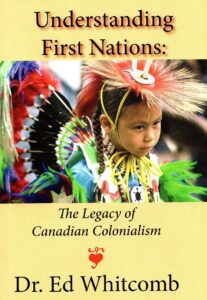Book review: Understanding First Nations: The Legacy of Canadian Colonialism
 By Karl Hele
Dr. Ed Whitcomb’s Understanding First Nations: The Legacy of Canadian Colonialism is an overview of First Nations issues in Canada up to 2019. It is directly aimed at explaining these issues to non-Indigenous Canadians in simple language as an aid to creating a basic understanding that may or may not lead to further inquiries. Whitcomb does hope that in reading the volume, non-Indigenous Canadians will better understand First Nations to move reconciliation forward. The volume admittedly does not claim an exhaustive overview nor a solution to the issues. Regardless, over 17 chapters and within 174 pages Whitcomb explores the definition of Indian, history, myths, sovereignty, treaties, reserve lands, the Indian Act, Indian Residential Schools, justice and welfare policies, Murdered and Missing Indigenous Women, education, health, housing, ideas of consultation, and reconciliation, as well as offering suggestions in the conclusion to the question, “Where do we go from here?”
By Karl Hele
Dr. Ed Whitcomb’s Understanding First Nations: The Legacy of Canadian Colonialism is an overview of First Nations issues in Canada up to 2019. It is directly aimed at explaining these issues to non-Indigenous Canadians in simple language as an aid to creating a basic understanding that may or may not lead to further inquiries. Whitcomb does hope that in reading the volume, non-Indigenous Canadians will better understand First Nations to move reconciliation forward. The volume admittedly does not claim an exhaustive overview nor a solution to the issues. Regardless, over 17 chapters and within 174 pages Whitcomb explores the definition of Indian, history, myths, sovereignty, treaties, reserve lands, the Indian Act, Indian Residential Schools, justice and welfare policies, Murdered and Missing Indigenous Women, education, health, housing, ideas of consultation, and reconciliation, as well as offering suggestions in the conclusion to the question, “Where do we go from here?”
Overall, the book is a quick read and as the author intended, offers a general overview of issues. Despite the summary nature of the volume, Whitcomb does show how the federal government regularly violates the ‘rule of law’ through its actions as well as how deliberate underfunding has created the conditions seen in First Nations. Whitcomb’s explanation of Indigenous understandings of ‘ownership’ and ‘sovereignty’ while simple is highly effective. He writes that Indigenous people view sovereignty as resting with the Creator, meaning it cannot be surrendered; while ownership rests with the occupation of territory which can be shared with others. This is highly effective at demonstrating and explaining differences in understandings when it comes to land and treaties.
Nonetheless, Understanding First Nations is not without its issues. Part of the problem is the simplification, condensation, or summary of issues stemming from more than 150 years of Canadian colonialism. For instance, the author uncritically assumes that the 86 Indigenous languages in Canada around 1600AD are representative of the number of actual First Nations in Canada. This allows Whitcomb to then assume that the 634 Bands in Canada are merely creations of the British or Canadian state, which is a huge oversimplification of complicated Indigenous histories and narratives as well as colonial history. Whitcomb’s language, which he addresses or excuses in the introduction as a means to aid non-Indigenous understanding, continues to promote Settler assumptions and understandings – for example, Pontiac did not lead an “uprising” (14), people were captured, not “kidnapped” (12), lands where the French settled were not “vacant” (12), the Royal Proclamation was not a “treaty” (36), and the Beothuk did not simply “die off” (33). Other phrases like “bandwagon” (vi) need to be removed.
Likewise, in trying to dispel myths, Whitcomb falls into repeating other Settler myths. This is most evident when he is trying to explain why First Nations drank and continue to drink alcohol. Whitcomb argues that First Nations drank for visions or dreams (23-4), which itself is a myth. A better explanation of the Indian Act would also help. His oversimplification of the Indian Act and attendant policies at times are confusing or misleading, albeit the summary does contribute to the aim of the work by illustrating Canadian colonialism. Simply, Chapters 1 to 3 and 5 to 7 need to be rewritten with more research into the topics covered. Other chapters dealing with more contemporary issues need to be updated in light of Liberal Party actions and inactions as well as the ongoing demands for removal of statues and the uncovering of hundreds of unmarked graves at former Indian Residential School sites.
Although the work does need some edits and an update in several chapters, these issues do not take away from the work’s overall intent or potential impact on non-Indigenous readers. This book achieves its goals to offer a simple short narrative to understanding First Nations issues in Canada. In its entirety, Understanding First Nations is a start. Indigenous readers, depending on age and experience, may learn tidbits here and there throughout the book but its real utility rests in its potential to educate non-Indigenous Canadians and perhaps as a text for high schools — both students and educators.
Dr. Ed Whitcomb. Understanding First Nations: The Legacy of Canadian Colonialism. Ottawa: From Sea to Sea Enterprises, 2019.
ISBN: 978-0986596742


